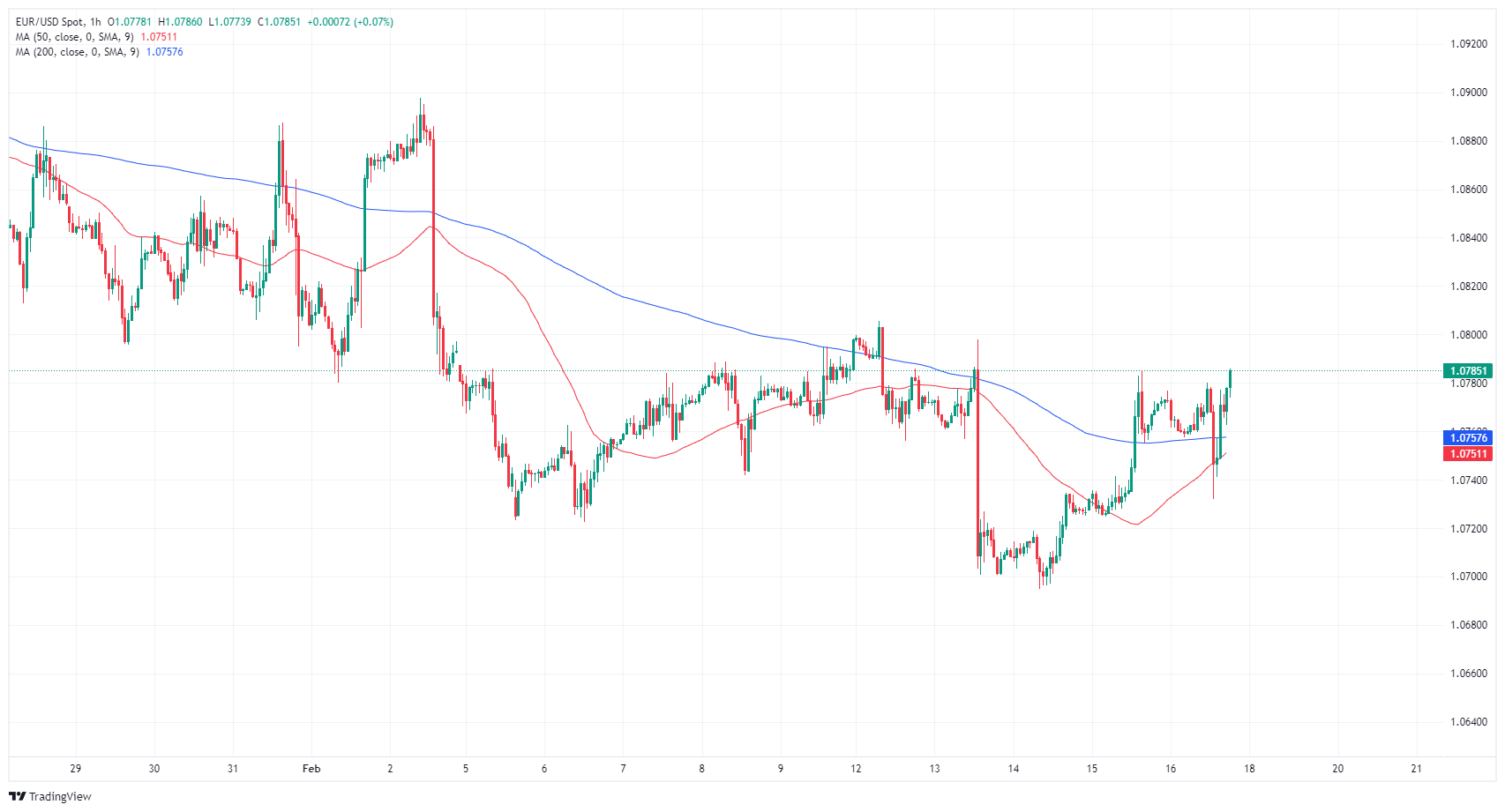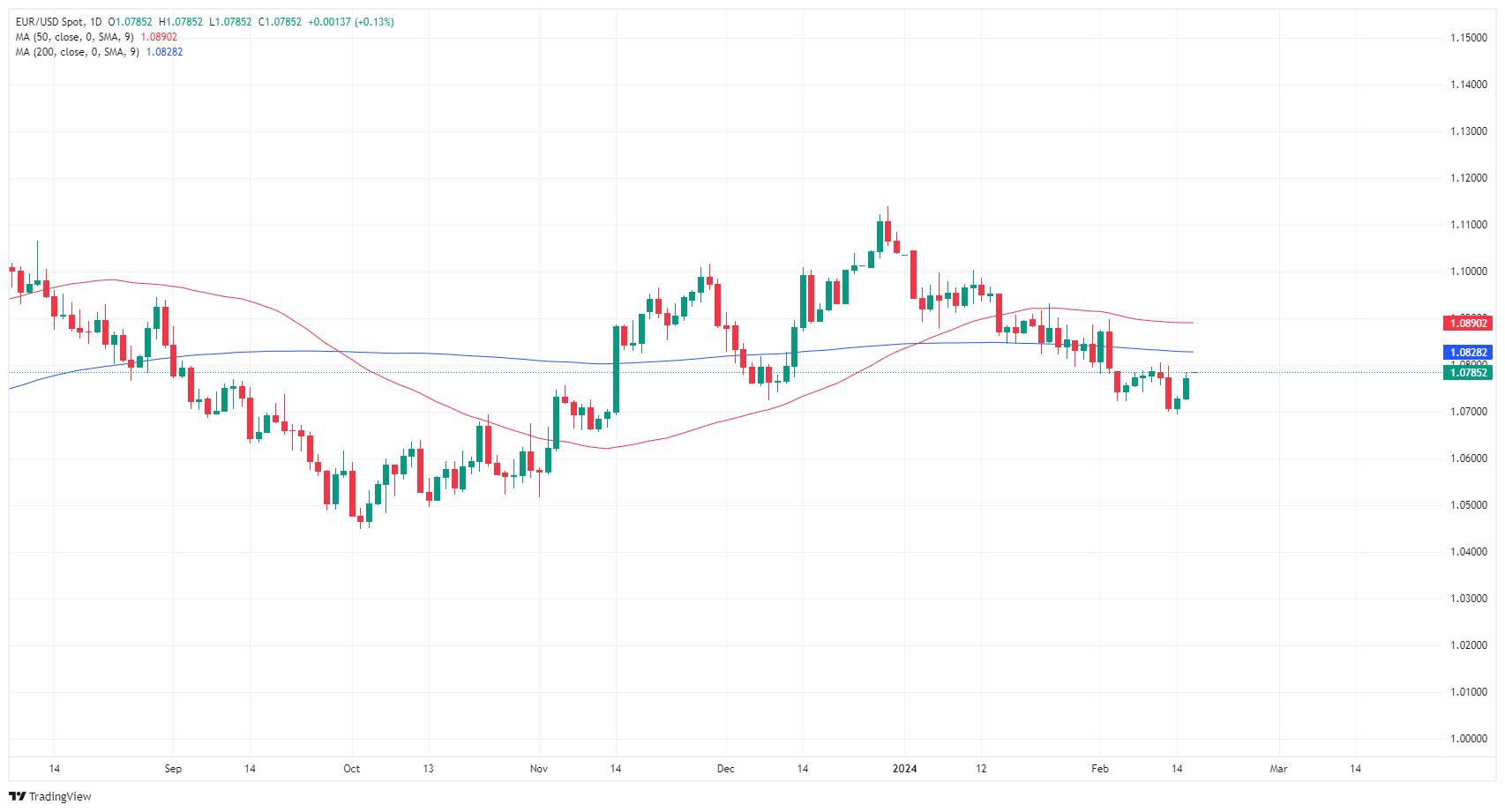- EUR/USD continues to test a near-term ceiling at 1.0780.
- European PMIs slated for next Thursday, thin data until then.
- US PPIs rose on Friday, pinning markets into the midrange.
EUR/USD is spinning in place on Friday after a brief test into the low side, but tepid markets are keeping the pair hamstrung near the day’s opening bids as traders buckle down for the week’s closing bell.
The Euro (EUR) sees thin economic data until next week’s Purchasing Manager’s Index (PMI) figures, and US data gave traders little to chew on after the US Producer’s Price Index (PPI) rose instead of falling. US markets will be dark on Monday for the President’s Day holiday, and traders will be waiting until Wednesday’s Federal Reserve (Fed) Meeting Minutes for hints about how close (or far) the US central bank is from trimming interest rates.
Daily digest market movers: EUR/USD struggles to break out of near-term congestion
- US Core annualized PPI rose to 2.0% for the year ended in January, climbing over the forecast 1.6% and the previous period’s 1.7% (revised from 1.8%).
- MoM US PPI rose by 0.3% in January, accelerating above the forecast rebound to 0.1% from the previous month’s -0.1%.
- The Michigan Consumer Sentiment Index rose to 79.6 for February, but less than the forecast 80.0 from January’s 79.0.
- The University of Michigan’s 5-year Consumer Inflation Expectations survey held steady at 2.9% in February.
- Still-high inflation expectations and rising producer-level inflation continue to vex investors hungry for rate cuts from the Fed.
- Next week sees the Federal Open Market Committee’s (FOMC) latest Meeting Minutes, slated to release on Wednesday.
- The Euro sees only light data on the calendar until next Thursday’s Purchasing Manager’s Index (PMI) print.
- The pan-European HCOB Composite is expected to rise slightly to 48.5 in February from January’s 47.9.
- Europe’s HCOB Composite PMI has been in contraction territory below 50.0 since July of last year.
Canadian Dollar price today
The table below shows the percentage change of Canadian Dollar (CAD) against listed major currencies today. Canadian Dollar was the strongest against the Japanese Yen.
| USD | EUR | GBP | CAD | AUD | JPY | NZD | CHF | |
| USD | -0.12% | -0.17% | 0.08% | -0.25% | 0.13% | -0.37% | -0.01% | |
| EUR | 0.12% | -0.07% | 0.20% | -0.12% | 0.24% | -0.24% | 0.11% | |
| GBP | 0.16% | 0.05% | 0.25% | -0.09% | 0.30% | -0.20% | 0.18% | |
| CAD | -0.09% | -0.20% | -0.25% | -0.33% | 0.05% | -0.46% | -0.09% | |
| AUD | 0.26% | 0.16% | 0.11% | 0.35% | 0.40% | -0.09% | 0.27% | |
| JPY | -0.12% | -0.24% | -0.28% | -0.06% | -0.39% | -0.48% | -0.11% | |
| NZD | 0.36% | 0.26% | 0.20% | 0.45% | 0.12% | 0.50% | 0.38% | |
| CHF | -0.02% | -0.13% | -0.18% | 0.07% | -0.26% | 0.12% | -0.38% |
The heat map shows percentage changes of major currencies against each other. The base currency is picked from the left column, while the quote currency is picked from the top row. For example, if you pick the Euro from the left column and move along the horizontal line to the Japanese Yen, the percentage change displayed in the box will represent EUR (base)/JPY (quote).
Technical analysis: EUR/USD struggles to build bullish momentum, 1.0800 remains the level to beat
EUR/USD is stuck in churn around the 200-hour Simple Moving Average (SMA) near 1.0760 with the pair struggling to find the topside momentum needed to reclaim the 1.0800 handle. EUR/USD has tested in both directions on Friday, and the pair is testing a scant tenth of a percent up on the day at the time of writing.
The EUR/USD is on pace to close on the down side of the 200-day SMA near 1.0830 for the tenth consecutive trading day as the pair gets plagued by regular bearish shocks, and bidders are struggling to dig their heels in and prevent further downside. The pair is still down over 3% from December’s peak bids near 1.1140.
EUR/USD hourly chart
EUR/USD daily chart
Inflation FAQs
Inflation measures the rise in the price of a representative basket of goods and services. Headline inflation is usually expressed as a percentage change on a month-on-month (MoM) and year-on-year (YoY) basis. Core inflation excludes more volatile elements such as food and fuel which can fluctuate because of geopolitical and seasonal factors. Core inflation is the figure economists focus on and is the level targeted by central banks, which are mandated to keep inflation at a manageable level, usually around 2%.
The Consumer Price Index (CPI) measures the change in prices of a basket of goods and services over a period of time. It is usually expressed as a percentage change on a month-on-month (MoM) and year-on-year (YoY) basis. Core CPI is the figure targeted by central banks as it excludes volatile food and fuel inputs. When Core CPI rises above 2% it usually results in higher interest rates and vice versa when it falls below 2%. Since higher interest rates are positive for a currency, higher inflation usually results in a stronger currency. The opposite is true when inflation falls.
Although it may seem counter-intuitive, high inflation in a country pushes up the value of its currency and vice versa for lower inflation. This is because the central bank will normally raise interest rates to combat the higher inflation, which attract more global capital inflows from investors looking for a lucrative place to park their money.
Formerly, Gold was the asset investors turned to in times of high inflation because it preserved its value, and whilst investors will often still buy Gold for its safe-haven properties in times of extreme market turmoil, this is not the case most of the time. This is because when inflation is high, central banks will put up interest rates to combat it.
Higher interest rates are negative for Gold because they increase the opportunity-cost of holding Gold vis-a-vis an interest-bearing asset or placing the money in a cash deposit account. On the flipside, lower inflation tends to be positive for Gold as it brings interest rates down, making the bright metal a more viable investment alternative.